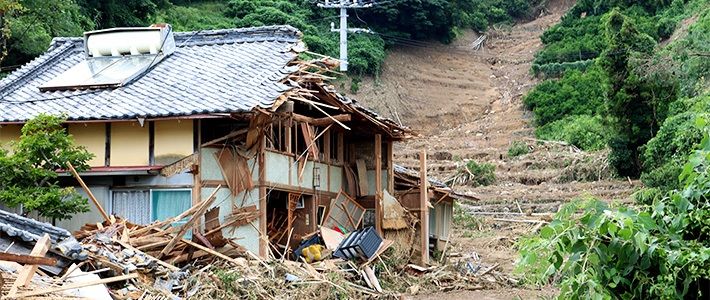
Rain-Related Disasters Becoming More Frequent in Japan
Society- English
- 日本語
- 简体字
- 繁體字
- Français
- Español
- العربية
- Русский
As of July 12, 2018, the death toll for torrential rains that swept across western Japan had risen to 200 people in 12 prefectures. Hiroshima, Okayama, and Ehime Prefectures were hit hardest by the downpours that caused landslides and flooding.
It is by far the worst rain-related disaster since Japan entered the Heisei period in 1989. According to a Cabinet Office white paper on disaster management, Typhoon Tokage in 2004 and Typhoon Talas in 2011 each claimed 98 victims. As there are still many people missing and unaccounted for in the present disaster, the number of deaths may well climb further.
Looking at the below list of previous disasters, it is striking how often they occur in July. Frequently, warm, moisture-laden air, as from a typhoon, flows into a stationary seasonal rain front to trigger a deluge. Since 2000, this pattern seems increasingly common.Major Rain Disasters Since 1960
June 1961
Rain across the nation, excluding Hokkaidō, leaves 357 people dead or missing and causes underwater flooding in 340,000 homes.July 1964
Record-breaking rain on the Sea of Japan coast causes landslides in Izumo, Shimane Prefecture. More than 130 people are killed or missing.July 1967
Rain centered on Sasebo, Nagasaki Prefecture, causes 351 deaths and underground flooding in 250,000 homes.July 1972
Heavy rain from western Japan to southern Kantō. A total of 447 people are killed or go missing and underground flooding affects 270,000 homes.July 1982
Intense rainfall, centered on Nagasaki Prefecture, leads to 439 people dead or missing and underground flooding in 270,000 homes.July 1983
Major rain along Honshū’s Sea of Japan coast results in landslides and flooding, leaving 117 people dead or missing.August 1993
Heavy rain causes landslides, mainly in Kagoshima Prefecture. A total of 93 people are killed or unaccounted for.July 2004
Severe downpours in Niigata and Fukushima Prefecture kill 16 people.July 2004
Miyama in Fukui Prefecture receives 96 millimeters of rain in one hour. The intense downpour results in five people dead or missing.July 2006
Record-breaking deluges leave 30 people dead or missing, mainly in Kagoshima, Kumamoto, and Shimane Prefectures.August 2008
Record-breaking torrential rain falls mainly in Aichi Prefecture, killing two and causing underground flooding in 20,000 homes.July 2009
A total of 36 people are killed as more than twice the average rainfall for July falls in northern Kyūshū.July 2011
More than twice the average rainfall for July falls in four days, resulting in six people dead or missing.September 2011
Sustained heavy rainfall, centered on Wakayama and Mie Prefectures, leaves 98 people dead or missing.July 2012
Lengthy local downpours in Kumamoto and Ōita Prefectures result in 33 people dead or missing.August 2014
A localized deluge causes multiple landslides in the city of Hiroshima. There are 77 fatalities.October 2014
Rivers flooding and numerous landslides, mainly in western Japan, lead to a total of 98 people dead or missing.September 2015
Heavy rains cause an embankment to collapse on the Kinugawa river. A total of 14 people are killed nationwide.July 2017
Landslides, mainly in Fukuoka and Ōita Prefectures, cause 40 deaths.July 2018
Landslides and floods cause more than 200 deaths with Okayama and Hiroshima Prefectures most seriously affected.Created by Nippon.com based on materials published by the Japan Meteorological Agency, the Cabinet Office, the Fire and Disaster Management Agency, and others. Figures did not always agree, due to differing totaling methods.
(Translated from Japanese. Banner photo: The effects of a landslide in Uwajima, Ehime Prefecture. Picture taken on July 9, 2018. © Jiji.)